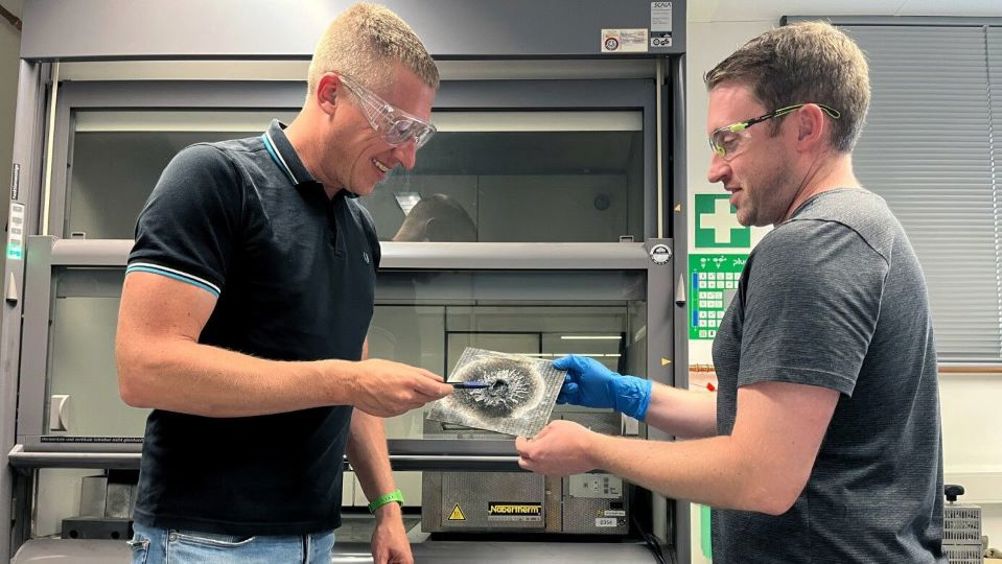The high resistance of this composite to the extreme conditions of a battery cell fire can be attributed to the non-flammable long and continuous fibers that reinforce the material in a multi-layer structure.
“It’s thanks above all to the fibers that our structural material is capable of withstanding the extreme pressures, temperatures well in excess of 1000°C, and bombardment by abrasive hot particles that occur during the thermal runaway of battery cells,” says Dr Dirk Bonefeld, Head of Tepex Product Management. “This is why it’s also ideal for components inside the battery such as the cell housing, holder and partitions.”
Vehicle battery cells are at risk of exothermic chemical reactions leading to fires as a result of factors such as electrical malfunctions, overheating and mechanical damage. This process is known as “thermal runaway.” If the fire spreads from one cell to the next, this is known as “thermal propagation.” Every effort must be made to ensure that the fire does not spread to the entire vehicle and endanger the occupants. This is why the battery housing plays a key role in containing fires. Thermal runaway tests simulate the extreme stresses to which the battery housing is exposed when a fire breaks out.

“Our new composite can pass the standard tests covering this eventuality – such as the BETR (battery enclosure thermal runaway) test to UL 2596 – with test specimen thicknesses of just two millimeters or even less,” says Bonefeld. And even with wall thicknesses of just two millimeters, the material easily meets the requirements of the battery stress test involving particle bombardment, as conducted by fire protection company svt Holding GmbH.
“Even upon exposure to particle bombardment, the Tepex test specimen did not undergo burnthrough, neither when the temperature at the end of the test was as high as 1400°C nor for another 20 seconds after – and that’s without any additional protective measures in the material and without supporting metal sheets. So even with low wall thicknesses and, in turn, low weight, a high degree of safety is ensured,” says Bonefeld.
The composite also acts as an effective barrier against external fire sources. In the fire pan test, which is based on UN regulation 180, 6.2.4, and simulates highly realistic battery fire scenarios in accident situations, burning fuel did not create holes in the material, and the fibers did not ignite.
The material is also much lighter than steel or aluminum.
“The density of an exclusively glass-fiber-reinforced material variant is around 70% less than that of steel. And if the core layer of the composite is reinforced with carbon fibers, this difference in density is even greater. So compared with aluminum, our composite can be significantly more than one third lighter,” says Bonefeld.
The composite comprises several layers of long and/or continuous fibers. Depending on the requirements, each layer can be reinforced with special fiber textiles. The total fiber content in the composite is more than 50% by weight. Polyamides or other engineering plastics can be used as matrix materials.
“In particular, the huge freedom of choice when it comes to fibers, fiber arrangements, and matrix materials is a major strength of our material. This means that it can be specially adapted to individual requirements,” says Bonefeld. The composite is also available in a variant containing recycled carbon fibers, putting the proportion of recycled material in the composite as a whole at around 36% by weight. “This composite is especially good for housings that are subject to very high mechanical loads. And the carbon fibers make it the material of choice when the housing needs to be electromagnetically shielding,” says Bonefeld. This shielding ensures that any equipment in or near the battery is not exposed to electrical or electromagnetic interference.
As a thermoplastic material, the new composite can be easily recycled, meaning that production waste such as offcuts can be easily shredded and then reused as quality assured recycled compounds for injection molding. Components can also be recycled in this way. Composites and components can also be recycled by means of solvolysis and depolymerization. “Our new material is therefore perfect for creating sustainable material cycles,” says Bonefeld.
Envalior was formed as a result of the merger of DSM Engineering Materials (DEM) and Lanxess High Performance Materials (HPM).







